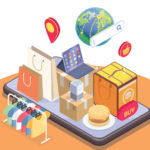
How to Set Up Salesforce Consumer Goods Cloud for Improved Direct Store Delivery (DSD)
As the demand for online shopping grows, staying competitive in the retail industry demands extra effort. Many companies are shifting from traditional multi-stage distribution to Direct Store Delivery (DSD) to meet customer needs effectively. With this shift comes the need for streamlined processes, which is where Salesforce Consumer Goods Cloud comes in.
In this article, we’ll break down what Direct Store Delivery (DSD) is all about, showcase how Salesforce Consumer Goods Cloud simplifies it, and walk you through the steps to set up this invaluable tool for the Consumer Goods Industry.
What is Direct Store Delivery?
Direct Store Delivery (DSD) is a distribution strategy wherein suppliers or manufacturers bypass the intermediary step of sending products to warehouses or distribution centers. Instead, they deliver goods directly to retail stores, where they are immediately available for sale to consumers. This approach offers several advantages, including reduced handling and transit times, faster, fresher products reaching shelves, and lower inventory management and distribution costs.
How does the Consumer Goods Cloud Help streamline direct store delivery processes?
Here is how Salesforce Consumer Goods Cloud remarkably and effectively streamlines direct store delivery processes:
Visibility and Prioritization
Sales managers in the Consumer Goods Industry gain a clear view of all orders within their region, allowing them to prioritize based on store performance.
Task Assignment
With Consumer Goods Cloud, managers can easily create and assign delivery tasks to drivers, who can access them conveniently on their mobile devices.
Accessible Across Platforms
This functionality is available in Lightning Experience across multiple editions (Developer, Performance, Enterprise, and Unlimited) where Consumer Goods Cloud is enabled.
Permission Requirement
Users need the Lightning Direct Store Delivery permission set to utilize this feature effectively.
Task Creation and Management
Managers utilize action plan templates to create delivery tasks, assigning them to specific visits.
Efficient Tracking
After drivers complete deliveries, they can promptly record the number of items delivered, ensuring accurate tracking and efficient management of the delivery process.
How To Setup Salesforce Consumer Goods Cloud?
Here is the Salesforce DSD setup guide to help you streamline your direct store delivery processes:
Initiate The Consumer Goods App
This step involves assigning the Consumer Goods app to the administrator profile responsible for managing resources. The app consolidates all relevant resources into one accessible location, making it easier to create, configure, and manage them effectively.
Configure User Roles and Permissions For Retail Execution
In this step, user roles and permissions are defined to ensure that the right individuals have access to visit and task management features. Sales managers and field reps involved in direct store delivery need appropriate permissions to efficiently view, create, and manage visits and tasks.
Activate Essential Features For Your Organization
This involves activating Retail Execution features within your Salesforce org and configuring action plan templates. Action plan templates are essential for assigning visits to specific locations, ensuring that delivery tasks are organized and managed effectively.
Grant Access To The Consumer Goods Mobile App
Granting access to the Consumer Goods Mobile App enables field reps to manage delivery tasks. This access allows them to view assigned visits, update task statuses, and communicate with the team, enhancing overall efficiency and productivity in direct store delivery operations.
Integrate Visits Into The Retail-Related List
Enhancing visibility by adding visits to the Retail Store-related list enables easy tracking of delivery schedules for each store. This feature allows sales managers to monitor upcoming visits, review visit histories, and ensure delivery tasks are timely.
Include Orders In The Retail Store Related List
Including orders in the related list allows tracking placed orders for each store. This capability enables sales managers to monitor order statuses, track order fulfillment, and ensure delivery tasks align with customer demand and inventory levels.
Enable Salesforce Calendar For Efficient Planning
Enabling the Salesforce Calendar provides visibility into scheduled visits and allows sales managers and field reps to plan delivery routes effectively. By viewing scheduled visits on the calendar, field reps can optimize their routes, minimize travel time, and ensure timely delivery of goods to retail stores.
Conclusion
In conclusion, implementing Salesforce Consumer Goods Cloud can significantly enhance the efficiency and effectiveness of direct store delivery processes. Businesses can ensure timely deliveries and better serve their customer needs by streamlining tasks such as visit scheduling, order tracking, and mobile access to critical data.
Businesses can turn to certified consultants like Manras for expert guidance and support in implementing Salesforce Consumer Goods Cloud. With in-depth knowledge and experience, Manras can provide tailored solutions to meet the unique needs of retail businesses, ensuring successful implementation and maximum benefit from Salesforce cloud-based solutions.



